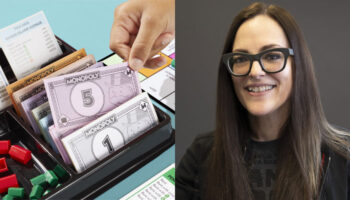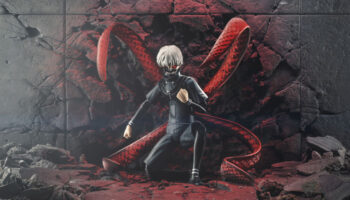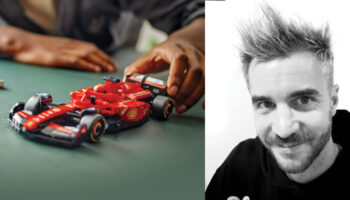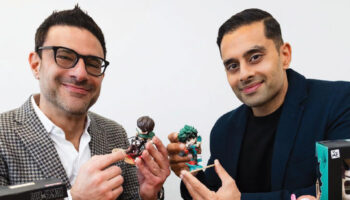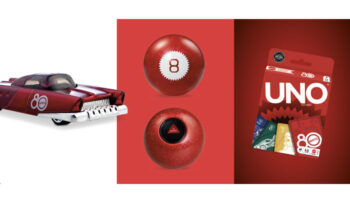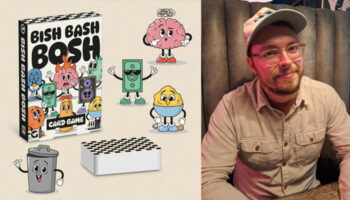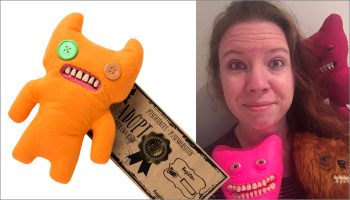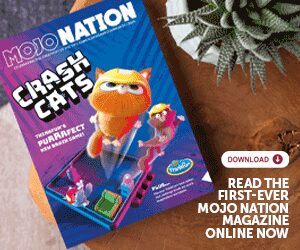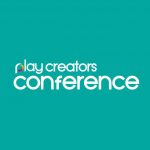Designer Stephen Wilson on the origins of Bish Bash Bosh
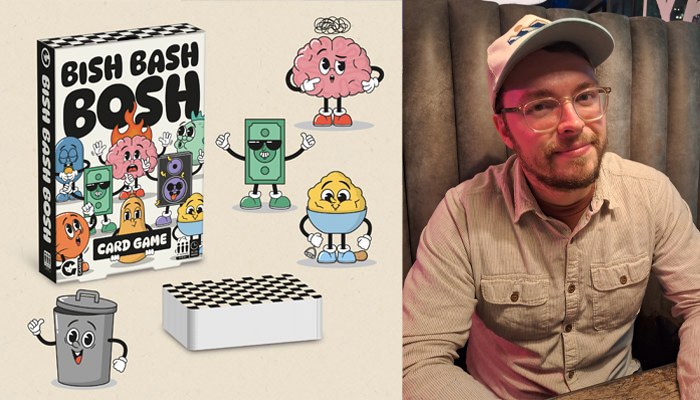
Stephen, it’s great to catch up. Let’s talk Bish Bash Bosh! For anyone new to the game, how would you pitch it?
Thanks Billy, my pleasure. It’s a classic race to play all your cards first, with lots of noise, excitement and anticipation. Put simply, cards are played in a repeated sound order: ‘ish,’ then ‘ash,’ then ‘osh.’ There are six of each of these sounds in the deck, with some alliterative cards able to disrupt the normal clockwise flow of gameplay. For example, any player can follow ‘dish’ with ‘dash.’ This promotes high levels of engagement, as you’re constantly looking to ‘snipe’ your opponent and play a special link card from your hand – or act fast enough to prevent your opponent from doing so. There’s also a nice hint of emerging mischievous strategy as you go from learning how to play to learning how to win. But I’ll keep that to myself for now.
Ha! And how did the idea for this take shape?
Bish Bash Bosh was inspired by a riotous drinking game that kickstarted many a night out in my younger days: Ping Pang Pong. I had wanted to develop its central mechanism into a family game for some time, but couldn’t quite get any ideas to work. Like many game inventors, I’m constantly listening out for interesting words or phrases as a spark of inspiration. It wasn’t new to me, but while wrestling with the Ping Pang Pong mechanic one day, I overheard someone say: “Bish Bash Bosh”. Something clicked straight away!
In what way?
Well, my main stumbling block up until then had been the lack of other real words that rhymed with “ping,” “pang,” and “pong”. This was no problem with “bish,” “bash,” and “bosh”… Within 24 hours, I had printed a deck and begun testing. The result was an accessible card game with a great central mechanism. I pitched it two weeks later to Ginger Fox.

Terrific! And what made Ginger Fox an ideal home for the game?
I met the awesome Ginger Fox team initially at a Mojo Pitch event two years prior. They took two of my games in for review and, although they weren’t signed, I think they recognised that my ideas aligned strongly with what they were looking for – noisy, fun, exciting, accessible and with simultaneous play.
No doubt these strengths resonated with the team when I first shared Bish Bash Bosh with them during an online pitch. Communication had always been a strength of Ginger Fox’s Louisa Osmond and Lewis Allen, and they both gave me great confidence through every interaction that Bish Bash Bosh would be safe in their hands. It’s worth noting how amazingly they’ve done on design and development – it’s turned out far better than I could ever have imagined.
This has been the first game you’ve licensed to a publisher. How has the process been?
Lewis has been very helpful in answering my many questions! We had about a week of daily phone calls going over details in the contract. Louisa has headed up development and shared regular updates throughout the process. She’s keen to get my input and thoughts on things, and I appreciate being kept in the loop. At Toy Fair, I chatted with some of the wider Ginger Fox team, and there was a real, palpable sense of excitement and enthusiasm for Bish Bash Bosh. I mean, just look at the sweatshirts!

Ha! That’s when you know you’ve made it – swag! Now, as a ‘new designer,’ how have you found the industry so far? Welcoming to newcomers? Easy to navigate?
I’ve reflected on this a lot, and I am very thankful for the advice and help I’ve received at various stages along the way. Everyone wants everyone else to succeed. I feel I’ve been very fortunate with chance encounters that have definitely accelerated things for me. I was first recommended to attend your Mojo Pitch event by Ellie Dix after showing her a game at Airecon in North Yorkshire – something I remain very thankful for.
From there, I’ve been able to build relationships with various publishers, which have ultimately led to games being signed. Alongside getting to know publishers through the Mojo Pitch, I’ve also been fortunate to meet other designers and inventors. It was there I first met Matt Burtonwood, who has been a constant source of knowledge, ideas, and advice. I’ve felt very welcome in the industry from day one and have met some amazing people along the way.
That’s great to hear. You’re a teacher by day – does teaching inform how you approach game design at all?
Teachers have different brains. We make hundreds, even thousands, of small decisions each day – I think only air traffic controllers beat us on this! With eight years under my belt, I feel teaching has helped develop my critical thinking, problem-solving, analysis, reasoning, creativity and ability to evaluate potential outcomes… All skills that, as you’ll appreciate, certainly enhance approaches to game design.
Additionally, I’ve always worked in special schools, where classic teaching methods can be a poor fit for learners. To maximise engagement and promote memory and retention of learning, there has to be a really strong element of ‘fun’ or ‘play’ in every lesson.
On that, what fuels your creativity?
In recent years, I’ve become more and more grateful for boredom as a fuel for my creativity. Boredom is certainly no threat – it’s an opportunity to daydream and think differently about things. Each week at my children’s swimming lessons, I sit with a notepad and pen, set myself one parameter – such as a component or game mechanic – and try to fully outline a new game. Capitalising on boredom in this way has led me to some really interesting ideas. And if boredom is the fuel, I see novelty as the spark. This could be a novel word or phrase, an interesting new mechanic, an unusual component, or even a unique theme.
Now, with your permission, Billy, I’d like to take this metaphor all the way and talk a little about the oxygen that completes this ‘fire’ triangle of game design creativity.
Please do!
For me, the oxygen is success. By no means does this have to be the ultimate success of signing a hit game – it took me almost two years of pitching to sign my first. During this time, however, I enjoyed many mini successes that kept me motivated and made me feel like I really had something to offer… Great positive feedback following a pitch… A publisher reaching out, asking to hear my new ideas. It could be anything, really, but there has to be moments like this that vindicate and validate your creativity to help keep it alive.
It’s a great point. And on the flip-side, what kills your creativity?
I think having too many constraints kills my creativity. The great advantage an independent game designer has is the ability to go beyond briefs and come up with something surprising that wouldn’t be possible internally. We don’t have to keep lots of metrics and details in mind. We can focus on a central hook and build out from there, often in surprising and unexpected ways.
Stephen, thanks again – and congrats on Bish Bash Bosh!
–
To stay in the loop with the latest news, interviews and features from the world of toy and game design, sign up to our weekly newsletter here





